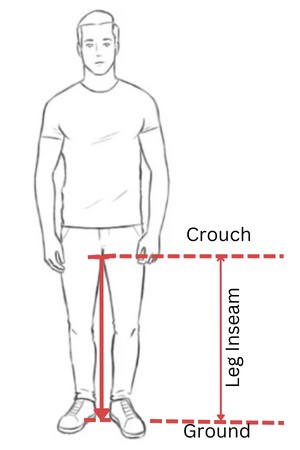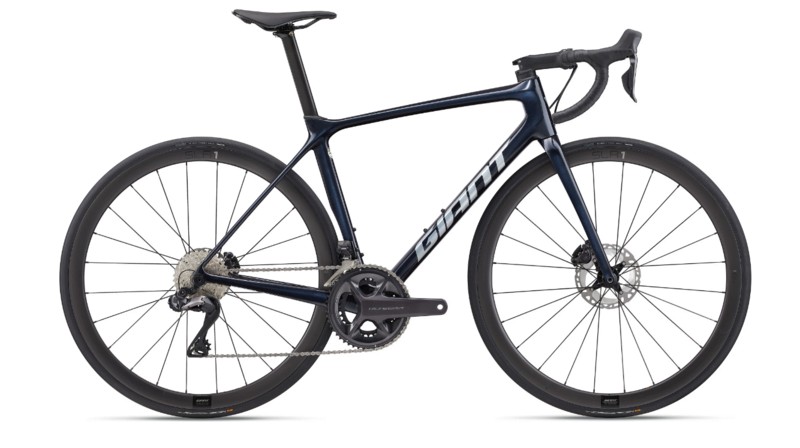A bike size chart is a bridge between a cyclist’s dream and reality. One that can be used to find the perfect bike according to height, leg length, weight, bike style, and saddle preferences.
Find out in this article what other factors are taken into consideration when sizing up a bicycle and why it’s vital to have a bike size chart on hand before making any purchase decisions.
What Factors to Consider When Choosing the Right Bike Size
Choosing the right bike size is one of the most important decisions you’ll make when buying a new bike. Bike sizes range from small to extra-large, and choosing the right size for your body type and riding style is important. Here are some tips on how to choose the right size of bike.
First, take your height and weight into account. Most bike manufacturers make their bikes in different sizes to fit a variety of body types and riding styles. Taller people with long legs typically need larger bikes, while shorter people may prefer smaller bikes with a shorter reach.
Next, consider your riding style. Do you plan on mostly riding on flat ground or taking on hills? If you’re going to be using your bike for transportation only, then go for a smaller size.
However, if you’re looking to ride more challenging terrain or race competitively, then go for a larger-size bike. Third, find out what type of riding you want to do. As an example, mountain bikers usually require a larger bike than road cyclists.
Finally, think about your intended use for the bike. If you’ll be using it mainly for transportation purposes, then go for a smaller-size bike. However, if you’re looking to use it for recreational rides, go for touring bikes.
Discover the Perfect Bike Size for You Using a Simple Math Method (Leg Inseam method)
We have prepared a quick formula you can use to find your bicycle size easily. To get your bicycle size, you need to multiply your leg inseam by the bike type.
How to Measure your Leg Inseam
Most bike sizes can be deceiving, so it’s important to get an accurate measurement for proper leg extension.

Here’s how to do it:
- Stand with your feet together and measure the distance from the floor to the top of your crotch. This is your inseam measurement.
- Next, take a piece of paper and draw a line down the middle. On one side, list your actual inseam measurement (in inches). On the other side, list the bike size that corresponds with that measurement (e.g., 26″ for an inseam of 28″).
- Now compare the two listings and choose the bike size that matches your measurements best. Be sure to keep in mind that bikes usually come in half sizes, so if you’re between sizes, go with the smaller size.
- Once you’ve chosen your bike, be sure to measure your leg inseam once more to ensure accuracy and get the right frame.
Note: Bike inseam measurements should be taken with a tape measure while standing with your feet together.
How to calculate your Bike Size using the Leg Inseam method
For a road bike – Multiply 0.70 by your leg inseam
For a city bike – Multiply 0.685 by your leg inseam
For a mountain bike – Multiply 0.685 by your leg inseam
For example: If your leg inseam is 70cm and you’re thinking of getting a city bike, then multiply 70 by 0.685. The answer would be 48.
Find Your Perfect Bike Size with the Bike Size Chart Method
Most bike manufacturers seem to offer a bewildering variety of bike sizes and frame types, so how do you know what size to get?
The bike size chart is a simple formula that will show you the measurements of different body types and help you choose the correct and perfect bike size for your needs.
Road Bikes Size Chart

If you’re wondering what size road bike is right for you, take a look at the chart below. This will give you a good idea of what size frame to look for based on your height. Keep in mind that these are just general guidelines and that you may need to adjust up or down depending on your specific body type.
Road bike size chart for men
| Height (ft/inches) | Height (cm) | Suggested Bike Frame size (cm) | Bike Frame Size (Marker) |
| 4′ 10″ – 5′ 0” | 148 – 152 | 47 – 48 | XXS |
| 5′ 0 “- 5′ 3” | 152 – 160 | 49 – 50 | XS |
| 5′ 3″ – 5′ 6″ | 160 – 168 | 51 – 52 – 53 | S |
| 5 6″ – 5′ 9″ | 168 – 175 | 54 – 55 | M |
| 5′ 9″ – 6′ 0″ | 175 – 183 | 56 – 57 – 58 | L |
| 6′ 0″ – 6′ 3″ | 183 – 191 | 58 – 59 – 60 | XL |
| 6′ 3″ – 6′ 6″ | 191 – 198 | 61 – 62 – 63 | XXL |
Women’s Road Bike Frame Size Chart
When choosing a bike size, keep in mind that not all women are the same size. The following bike size chart is based on average proportions for women.
| Height (ft/inches) | Height (cm) | Suggested Bike Frame size (cm) | Bike Frame Size (Marker) |
| 4′ 10″ – 5′ 1″ | 147 – 155 | 44 – 45 – 46 | XXS |
| 5′ 1″ – 5′ 3″ | 155 – 160 | 47 – 48 – 49 | XS |
| 5′ 3″ – 5′ 5″ | 160 – 165 | 50 – 51 – 52 | S |
| 5′ 5″ – 5′ 8″ | 165 – 172 | 53 – 54 – 55 | M |
| 5′ 8″ – 5′ 10″ | 172 – 180 | 56 – 57 | L |
The suggested bike frame sizes are meant to be a starting point, as every woman is different. If you are between sizes or have any questions, it is always best to consult with a professional before making your final decision.
Important Things to Know When Sizing a Mountain Bike

When you’re ready to buy a mountain bike, it’s important to take into account your height, weight, arm span, and riding experience.
To ensure a comfortable ride, it’s best to determine your bike size before shopping. Here are some key things to keep in mind when sizing a mountain bike:
- Stand on the pedals with your heels hanging off the end of the pedal stroke – this is your normal pedaling position. Pay attention to the top tube length and the seat tube length.
- Measure your inseam (distance from crotch to ground). This will give you your leg length and ensure leg extension.
- Compare that measurement to the specifications for bikes in that size range online or in a store.
Remember that different brands and models of mountain bikes will have different size charts, so be sure to consult with a shopkeeper before making a purchase. However, a mountain bike size chart can still help you to a great extent in decision-making.
Mountain Bike Size Chart
Mountain bike size is determined by the biker’s height, leg inseam, and the bike’s frame plus wheel size. Use this mountain bike sizing chart to determine your bike’s size.
Suggested Mountain Bike Chart for Men
| Height (ft/inches) | Height (cm) | Leg Inseam (inches) | Bike Frame Size (inches) | Bike Frame Size (Marker) | Wheel Size (inches) |
| 4’10” – 5’2” | 148-158 | 25” -28” | 13” -14” | XS | 26” |
| 5’2” – 5’6” | 158-168 | 25” -30” | 15” -16” | S | 26” |
| 5’6” – 5’10” | 168-178 | 26” -31” | 17” -18” | M | 27.5” |
| 5’10” – 6’1” | 178-185 | 27” -32” | 19” -20” | L | 27.5” |
| 6’1” – 6’4” | 185-193 | 28” -33” | 21” -22” | XL | 29” |
| 6’4” – 6’6” or more | 193-198 | 29” – 34” | 23” – 24” | XXL | 29” Plus |
Suggested Mountain Bike Size Chart for Women
| Height (ft/inches) | Height (cm) | Suggested Bike Frame Size (cm) | Suggested Bike Frame Size(Marker) |
| 4′ 10″ – 5′ 2″ | 148 – 158 | 13” – 14” | XS |
| 5′ 2″ – 5 ‘6″ | 158 – 168 | 15” – 16” | X |
| 5′ 6″ – 5′ 10″ | 168 – 178 | 17” – 18” | M |
| 5′ 10″ – 6′ 1″ | 178 – 185 | 19” + | L |
Hopefully, this chart will help you find the right mountain bike size per your need.
Hybrid Bike Size Chart

When you’re shopping for hybrid bikes, there are a few essential things to take into account, such as the correct bike size chart like the one below. This will help you narrow down the frame size that’s right for you based on your height and leg inseam.
Hybrid Bike Size Chart
| Height (ft/inches) | Height (cm) | Leg Inseam (inches) | Leg Inseam (cm) | Bike Frame Size (inches) | Bike Frame Size (Marker) |
| 4’10” – 5’1” | 147 -155 | 24” -29” | 61 -73 | 14” | XS |
| 5’1” – 5’5” | 155 -165 | 25” -30” | 63 -76 | 15” | S |
| 5’5” – 5’9” | 165 -175 | 26” -31” | 66 -78 | 16” | M |
| 5’9” – 6’0” | 175 -183 | 27” -32” | 68 -81 | 17” | L |
| 6’0” – 6’3” | 183 -191 | 28” -33” | 71 -83 | 18” | XL |
| 6’3” – 6’6” or more | 191 -198 | 29” – 34” | 73 -86 | 19” | XXL |
Once you’ve figured that out, it’s also important to consider the type of riding you’ll be doing. If you’re mostly planning on riding on paved surfaces, you’ll want a bike with narrower tires.
But if you anticipate hitting some dirt trails from time to time, wider tires will give you more stability and traction. With all of that in mind, use the chart and your own judgment to find the hybrid bike size that’s perfect for you.
Touring Bikes Size
Touring bikes are quite similar to road and commuter bikes. They have a longer wheelbase to make carrying panniers easy on a rear rack. Talking about positioning on these bikes so they come with handlebars in multiple positions.
This allows bikers enough freedom of changing hand positions which ultimately helps them sit more upright to relieve their back pressure.
Now it’s very important that you make the right adjustments on your bike before getting into the habit of riding. Because the wrong fit sometimes feels comfortable but in the long run does great harm to soft tissues, bones, and muscles.
One way to know your right fit is a touring bike’s frame size chart. Hopefully, this chart will help you pick the right bike.
It’s always best to try out a few different bikes before making your final decision. But hopefully, these charts will give you a starting point for finding the perfect road bike for your needs.
| Body Size (cm) | Bike Frame Size (cm) |
| 155 – 160 | 42 – 47 |
| 160 – 170 | 47 – 52 |
| 170 – 175 | 52 – 54 |
| 175 – 180 | 54 – 56 |
| 180 – 185 | 56 – 58 |
| 185 – 190 | 58 – 60 |
| 190 – 195 | 60 – 63 |
| Above 195 | Above 63 |
Cyclocross Bikes Size
Cyclocross bikes use exactly the same conventions as are used by road bikes. A prominent feature of this bike is its aggressive positioning.
They come in a diverse range of options so try out them all to understand the feel of each type. This may sound stupid to experiment but believe us it works quite well. And will ultimately leave you with the right choice.
| Body Size (cm) | Bike Frame Size (cm) |
| 155 – 160 | 47 – 49 |
| 160 – 165 | 49 – 51 |
| 165 – 170 | 51 – 53 |
| 170 – 175 | 53 – 55 |
| 175 – 180 | 55 – 57 |
| 180 – 185 | 57 – 60 |
| 185 – 190 | 60 – 62 |
| 190 – 195 | 62 – 64 |
| Above 195 | Above 64 |
Cruisers, Hybrids, or Cross Bikes Size

In reality, cruisers, hybrids, and cross bikes are all the same type of bike. They are quite affordable and most importantly come in various sizes to fit almost all. Even you can find their large and extra-large sizes without any sort of difficulty.
However, the cruiser makes an exception because it comes in only one size. But that can’t be a problem for any rider because they are not engineered for performance. And are only meant to be ridden for hardly a few hours.
With this now let’s understand their frame sizing. So, that you get a clear vision for your purchase.
| Height (ft/inches) | Height (cm) | Leg Inseam (inch) | Leg Inseam (cm) | Frame Size (inch) | Frame Size (Marker) | |
| 4’10” – 5’1” | 147 -155 | 24” – 29” | 61 – 73 | 14″ | XS | |
| 5’1″ – 5’5″ | 155 -165 | 25″ – 30″ | 63 – 76 | 15″ | S | |
| 5’5″ – 5’9″ | 165 -175 | 26″ – 31″ | 66 – 78 | 16″ | M | |
| 5’9″ – 6’0″ | 175 -183 | 27″ – 32″ | 68 – 81 | 17″ | L | |
| 6’0″ – 6’3″ | 183 -191 | 28″ – 33″ | 71 – 83 | 18″ | XL | |
| 6’1″ – 6’6″ | 191 -198 | 29″ – 34″ | 73 – 86 | 19″ | XXL |
Kids’ Bike Size Chart
When it comes to choosing the right bike for your child, the most important factor is wheel size. That’s because the wheels determine the bike’s overall size, and also affect how easy it is to ride.
Generally, kids’ bikes are sized by wheel diameter, with 12″, 16″, 20″, and 24″ being the most common sizes. The age and height range for each size is listed on most bike size charts. For example, a 12″ bike is usually suitable for kids aged 2-4 years old. Conversely, a 16″ bike is suitable for kids aged 5-7 years old, and so on.
A 14″ bike is usually suitable for kids aged 3-5 years old who have an inseam of 16-19 inches. And so on.
| Age (in Yrs) | Height (ft/inches) | Height (cm) | Suggested Bike Wheel Size (inch) |
| 2 – 4 | 2’ 10″ – 3’ 4” | 85 – 100 | Run bikes |
| 2 – 5 | 2’ 10″ – 3’ 7” | 85 – 110 | 12″ wheel diameter |
| 5 – 7 | 3’ 4” – 4’ 0” | 100 – 120 | 16″ wheel diameter |
| 7 – 9 | 4’ 0″ – 4’ 5” | 120 – 135 | 20″ wheel diameter |
| 9 – 11 | 4’ 5” – 4’ 9” | 135 – 145 | 24″ wheel diameter |
| 11+ | 4’ 9” + | 145+ | 26″ wheel diameter |
Of course, the best way to know if a bike is right for your child is to take them to a local bike shop where they can try out different models and sizes. However, these measurements we discussed will ease your work to a great extent.
Consult a Professional To Calculating Bike Size
Local bike shopkeepers are an invaluable resource. They’ll be able to take into account your height, weight, and riding style to come up with an accurate sizing recommendation. Ultimately ensuring that you get the perfect fit for your needs. Happy Shopping!
How Can I Fix the Wrong Bike Size?
If you have been unlucky enough to pick the right bike size, there are a few things that you can do to fix the problem.
First, check to see if your seat post is the right length. Most shops will have a variety of lengths available, so just make sure to get a 350mm long seat post. Next, adjust the angle of the stem by bending it either up or down depending on which way feels more comfortable.
Lastly, move your saddle back until it feels comfortable. Once you’ve found these three adjustments, make sure to test out your new position on the bike. If everything feels good, then you’re ready to go.
In case the above tricks don’t work, see a bike-fit specialist or an experienced biker for a professional bike fitting.
What if I am Between Two Sizes?
If you are between two bike sizes, the most important thing to remember is that the smaller size will fit more snugly and provide a more comfortable ride.
The bigger size may feel faster and allow for more riding range, but it can be uncomfortable after a while and cause feet to flat.
Ultimately, it is important to find a bike that fits you well and makes you feel comfortable on the ride.
How Can I Set the Right Bike Saddle Height?
If you’re new to bike riding or want to ensure your saddle is at the optimal height, then the “heel-to-pedal” method is a great way to go. This method relies on the logic that you’ll be most efficient when pedaling if your leg is almost entirely straight when at the bottom of a stroke.
This involves sitting on the bike and placing your heel on one pedal, then rotating the pedal to its lowest position (6 o’clock). From here, you should ensure that your leg is straight and that your heel is in line with the pedal’s center. Adjust the saddle height if your leg is not straight or your heel cannot reach to pedal.
Another precise way to calculate your saddle height is the “LeMond Method,” developed by legendary US racer Greg LeMond. To perform this, you’ll need a few basic tools for measurement purposes, such as a large book, measuring tape, a pencil, and a wall or similar flat vertical surface.
Stand against the wall with the book between your legs and measure your inseam height from the floor to the top of the book. Then multiply your inseam height by 0.883 to find the exact distance between the saddle top and the bottom bracket. This formula is bound to give you the most accurate saddle height for optimal performance.
Note: Getting your saddle height right can take a bit of trial and error, but it’s worth taking the time to get it right. Doing so will help you be more comfortable on the bike and improve your pedaling efficiency.
Bike Size Chart For Your Height — Final Words
Now we understand a bike size chart and its importance when buying a new bike. If you’re still confused, don’t hesitate to ask a question in the comments section below. We’ll be more than happy to answer it.
Still, if you have any suggestions or doubts, feel free to drop a comment below. I will be more than happy to assist you with your query. Please follow our Facebook Page for more guides like this.
Have fun riding…
Frequently Asked Questions — Bike Frame Size Chart
What is the difference between a “big” bike and a “small” bike?
A big bike is typically about 26 inches or 6 feet in length, while a small bike is about 16 inches or 4 feet in length.
How do I know if I need a big or small bike?
The best way to determine your size is to measure your height and your inseam, which is the distance from the crotch to the ground when you’re standing with your shoes off. Then compare those numbers against the chart.
If your height is within one inch of the corresponding size on the chart, then you should be fine with that size; if not, you may want to go up one size.
Can I ride a big bike on small streets?
No. A big city bike is designed for wide, open roads with plenty of room to maneuver. On smaller streets and roads, you’ll likely experience more difficulty keeping up with traffic and braking in time.
Related:
